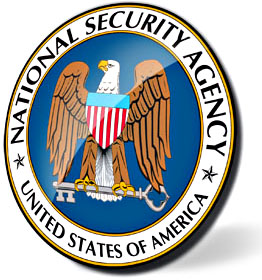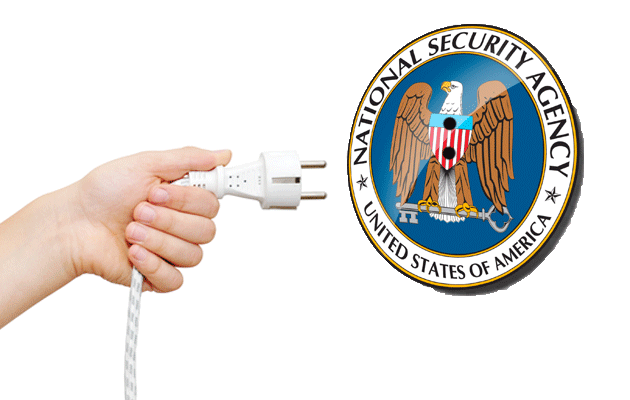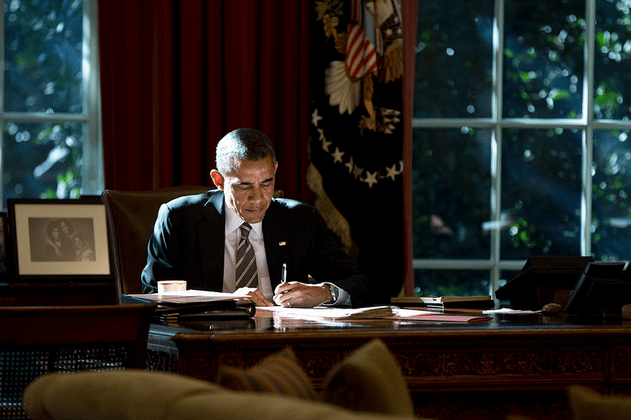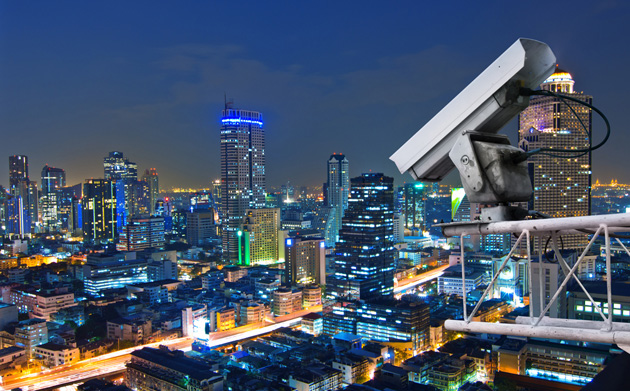
<a href="http://www.flickr.com/photos/truthout/4902199888/">Truthout.org</a>/Flickr
This story first appeared on the TomDispatch website.
For more than six months, Edward Snowden’s revelations about the National Security Agency (NSA) have been pouring out from the Washington Post, the New York Times, the Guardian, Germany’s Der Spiegel, and Brazil’s O Globo, among other places. Yet no one has pointed out the combination of factors that made the NSA’s expanding programs to monitor the world seem like such a slam-dunk development in Washington. The answer is remarkably simple. For an imperial power losing its economic grip on the planet and heading into more austere times, the NSA’s latest technological breakthroughs look like a bargain basement deal when it comes to projecting power and keeping subordinate allies in line— like, in fact, the steal of the century. Even when disaster turned out to be attached to them, the NSA’s surveillance programs have come with such a discounted price tag that no Washington elite was going to reject them.
![]() For well over a century, from the pacification of the Philippines in 1898 to trade negotiations with the European Union today, surveillance and its kissing cousins, scandal and scurrilous information, have been key weapons in Washington’s search for global dominion. Not surprisingly, in a post-9/11 bipartisan exercise of executive power, George W. Bush and Barack Obama have presided over building the NSA step by secret step into a digital panopticon designed to monitor the communications of every American and foreign leaders worldwide.
For well over a century, from the pacification of the Philippines in 1898 to trade negotiations with the European Union today, surveillance and its kissing cousins, scandal and scurrilous information, have been key weapons in Washington’s search for global dominion. Not surprisingly, in a post-9/11 bipartisan exercise of executive power, George W. Bush and Barack Obama have presided over building the NSA step by secret step into a digital panopticon designed to monitor the communications of every American and foreign leaders worldwide.
What exactly was the aim of such an unprecedented program of massive domestic and planetary spying, which clearly carried the risk of controversy at home and abroad? Here, an awareness of the more than century-long history of US surveillance can guide us through the billions of bytes swept up by the NSA to the strategic significance of such a program for the planet’s last superpower. What the past reveals is a long-term relationship between American state surveillance and political scandal that helps illuminate the unacknowledged reason why the NSA monitors America’s closest allies.
Not only does such surveillance help gain intelligence advantageous to US diplomacy, trade relations, and war-making, but it also scoops up intimate information that can provide leverage—akin to blackmail—in sensitive global dealings and negotiations of every sort. The NSA’s global panopticon thus fulfills an ancient dream of empire. With a few computer key strokes, the agency has solved the problem that has bedeviled world powers since at least the time of Caesar Augustus: how to control unruly local leaders, who are the foundation for imperial rule, by ferreting out crucial, often scurrilous, information to make them more malleable.
A Cost-Savings Bonanza With a Downside
Once upon a time, such surveillance was both expensive and labor intensive. Today, however, unlike the US Army’s shoe-leather surveillance during World War I or the FBI’s break-ins and phone bugs in the Cold War years, the NSA can monitor the entire world and its leaders with only 100-plus probes into the Internet’s fiber optic cables.
This new technology is both omniscient and omnipresent beyond anything those lacking top-secret clearance could have imagined before the Edward Snowden revelations began. Not only is it unimaginably pervasive, but NSA surveillance is also a particularly cost-effective strategy compared to just about any other form of global power projection. And better yet, it fulfills the greatest imperial dream of all: to be omniscient not just for a few islands, as in the Philippines a century ago, or a couple of countries, as in the Cold War era, but on a truly global scale.
In a time of increasing imperial austerity and exceptional technological capability, everything about the NSA’s surveillance told Washington to just “go for it.” This cut-rate mechanism for both projecting force and preserving US global power surely looked like a no-brainer, a must-have bargain for any American president in the twenty-first century—before new NSA documents started hitting front pages weekly, thanks to Snowden, and the whole world began returning the favor.
As the gap has grown between Washington’s global reach and its shrinking mailed fist, as it struggles to maintain 40% of world armaments (the 2012 figure) with only 23% of global gross economic output, the US will need to find new ways to exercise its power far more economically. As the Cold War took off, a heavy-metal US military—with 500 bases worldwide circa 1950—was sustainable because the country controlled some 50% of the global gross product.
But as its share of world output falls—to an estimated 17% by 2016—and its social welfare costs climb relentlessly from 4% of gross domestic product in 2010 to a projected 18% by 2050, cost-cutting becomes imperative if Washington is to survive as anything like the planet’s “sole superpower.” Compared to the $3 trillion cost of the US invasion and occupation of Iraq, the NSA’s 2012 budget of just $11 billion for worldwide surveillance and cyberwarfare looks like cost saving the Pentagon can ill-afford to forego.
Yet this seeming “bargain” comes at what turns out to be an almost incalculable cost. The sheer scale of such surveillance leaves it open to countless points of penetration, whether by a handful of anti-war activists breaking into an FBI field office in Media, Pennsylvania, back in 1971 or Edward Snowden downloading NSA documents at a Hawaiian outpost in 2012.
Once these secret programs are exposed, it turns out that nobody really likes being under surveillance. Proud national leaders refuse to tolerate foreign powers observing them like rats in a maze. Ordinary citizens recoil at the idea of Big Brother watching their private lives like so many microbes on a slide.
Cycles of Surveillance
Over the past century, the tension between state expansion and citizen-driven contraction has pushed US surveillance through a recurring cycle. First comes the rapid development of stunning counterintelligence techniques under the pressure of fighting foreign wars; next, the unchecked, usually illegal application of those surveillance technologies back home behind a veil of secrecy; and finally, belated, grudging reforms as press and public discover the outrageous excesses of the FBI, the CIA, or now, the NSA. In this hundred-year span—as modern communications advanced from the mail to the telephone to the Internet—state surveillance has leapt forward in technology’s ten-league boots, while civil liberties have crawled along behind at the snail’s pace of law and legislation.
The first and, until recently, most spectacular round of surveillance came during World War I and its aftermath. Fearing subversion by German-Americans after the declaration of war on Germany in 1917, the FBI and Military Intelligence swelled from bureaucratic nonentities into all-powerful agencies charged with extirpating any flicker of disloyalty anywhere in America, whether by word or deed. Since only 9% of the country’s population then had telephones, monitoring the loyalties of some 10 million German-Americans proved incredibly labor-intensive, requiring legions of postal workers to physically examine some 30 million first-class letters and 350,000 badge-carrying vigilantes to perform shoe-leather snooping on immigrants, unions, and socialists of every sort. During the 1920s, Republican conservatives, appalled by this threat to privacy, slowly began to curtail Washington’s security apparatus. This change culminated in Secretary of State Henry Stimson’s abolition of the government’s cryptography unit in 1929 with his memorable admonition, “Gentlemen do not read each other’s mail.”
In the next round of mass surveillance during World War II, the FBI discovered that the wiretapping of telephones produced an unanticipated byproduct with extraordinary potential for garnering political power: scandal. To block enemy espionage, President Franklin Roosevelt gave the FBI control over all US counterintelligence and, in May 1940, authorized its director, J. Edgar Hoover, to engage in wiretapping.
What made Hoover a Washington powerhouse was the telephone. With 20% of the country and the entire political elite by now owning phones, FBI wiretaps at local switchboards could readily monitor conversations by both suspected subversives and the president’s domestic enemies, particularly leaders of the isolationist movement such as aviator Charles Lindbergh and Senator Burton Wheeler.
Even with these centralized communications, however, the Bureau still needed massive manpower for its wartime counterintelligence. Its staff soared from just 650 in 1924 to 13,000 by 1943. Upon taking office on Roosevelt’s death in early 1945, Harry Truman soon learned the extraordinary extent of FBI surveillance. “We want no Gestapo or Secret Police,” Truman wrote in his diary that May. “FBI is tending in that direction. They are dabbling in sex-life scandals and plain blackmail.”
After a quarter of a century of warrantless wiretaps, Hoover built up a veritable archive of sexual preferences among America’s powerful and used it to shape the direction of US politics. He distributed a dossier on Democratic presidential candidate Adlai Stevenson’s alleged homosexuality to assure his defeat in the 1952 presidential elections, circulated audio tapes of Martin Luther King, Jr.’s philandering, and monitored President Kennedy’s affair with mafia mistress Judith Exner. And these are just a small sampling of Hoover’s uses of scandal to keep the Washington power elite under his influence.
“The moment [Hoover] would get something on a senator,” recalled William Sullivan, the FBI’s chief of domestic intelligence during the 1960s, “he’d send one of the errand boys up and advise the senator that ‘we’re in the course of an investigation, and we by chance happened to come up with this data on your daughter…’ From that time on, the senator’s right in his pocket.” After his death, an official tally found Hoover had 883 such files on senators and 722 more on congressmen.
 Armed with such sensitive information, Hoover gained the unchecked power to dictate the country’s direction and launch programs of his choosing, including the FBI’s notorious Counterintelligence Program (COINTELPRO) that illegally harassed the civil rights and anti-Vietnam War movements with black propaganda, break-ins, and agent provocateur-style violence.
Armed with such sensitive information, Hoover gained the unchecked power to dictate the country’s direction and launch programs of his choosing, including the FBI’s notorious Counterintelligence Program (COINTELPRO) that illegally harassed the civil rights and anti-Vietnam War movements with black propaganda, break-ins, and agent provocateur-style violence.
At the end of the Vietnam War, Senator Frank Church headed a committee that investigated these excesses. “The intent of COINTELPRO,” recalled one aide to the Church investigation, “was to destroy lives and ruin reputations.” These findings prompted the formation, under the Foreign Intelligence Surveillance Act of 1978, of “FISA courts” to issue warrants for all future national security wiretaps.
Surveillance in the Age of the Internet
Looking for new weapons to fight terrorism after 9/11, Washington turned to electronic surveillance, which has since become integral to its strategy for exercising global power.
In October 2001, not satisfied with the sweeping and extraordinary powers of the newly passed Patriot Act, President Bush ordered the National Security Agency to commence covert monitoring of private communications through the nation’s telephone companies without the requisite FISA warrants. Somewhat later, the agency began sweeping the Internet for emails, financial data, and voice messaging on the tenuous theory that such “metadata” was “not constitutionally protected.” In effect, by penetrating the Internet for text and the parallel Public Switched Telephone Network (PSTN) for voice, the NSA had gained access to much of the world’s telecommunications. By the end of Bush’s term in 2008, Congress had enacted laws that not only retrospectively legalized these illegal programs, but also prepared the way for NSA surveillance to grow unchecked.
Rather than restrain the agency, President Obama oversaw the expansion of its operations in ways remarkable for both the sheer scale of the billions of messages collected globally and for the selective monitoring of world leaders.
What made the NSA so powerful was, of course, the Internet—that global grid of fiber optic cables that now connects 40% of all humanity. By the time Obama took office, the agency had finally harnessed the power of modern telecommunications for near-perfect surveillance. It was capable of both blanketing the globe and targeting specific individuals. It had assembled the requisite technological tool-kit—specifically, access points to collect data,computer codes to break encryption, data farms to store its massive digital harvest, and supercomputers for nanosecond processing of what it was engorging itself on.
By 2012, the centralization via digitization of all voice, video, textual, and financial communications into a worldwide network of fiber optic cables allowed the NSA to monitor the globe by penetrating just 190 data hubs—an extraordinary economy of force for both political surveillance and cyberwarfare.
Click here to see a larger version
In this Top Secret document dated 2012, the NSA shows the “Five Eyes” allies (Australia, Canada, New Zealand, United Kingdom) its 190 “access programs” for penetrating the Internet’s global grid of fiber optic cables for both surveillance and cyberwarfare. (Source:NRC Handelsblad, November 23, 2013).
With a few hundred cable probes and computerized decryption, the NSA can now capture the kind of gritty details of private life that J. Edgar Hoover so treasured and provide the sort of comprehensive coverage of populations once epitomized by secret police like East Germany’s Stasi. And yet, such comparisons only go so far.
After all, once FBI agents had tapped thousands of phones, stenographers had typed up countless transcripts, and clerks had stored this salacious paper harvest in floor-to-ceiling filing cabinets, J. Edgar Hoover still only knew about the inner-workings of the elite in one city: Washington, D.C. To gain the same intimate detail for an entire country, the Stasi had to employ one police informer for every six East Germans—an unsustainable allocation of human resources. By contrast, the marriage of the NSA’s technology to the Internet’s data hubs now allows the agency’s 37,000 employees a similarly close coverage of the entire globe with just one operative for every 200,000 people on the planet.
A Dream as Old as Ancient Rome
In the Obama years, the first signs have appeared that NSA surveillance will use the information gathered to traffic in scandal, much as Hoover’s FBI once did. In September 2013, the New York Times reported that the NSA has, since 2010, applied sophisticated software to create “social network diagrams…, unlock as many secrets about individuals as possible…, and pick up sensitive information like regular calls to a psychiatrist’s office, late-night messages to an extramarital partner.”
Through the expenditure of $250 million annually under its Sigint Enabling Project, the NSA has stealthily penetrated all encryption designed to protect privacy. “In the future, superpowers will be made or broken based on the strength of their cryptanalytic programs,” reads a 2007 NSA document. “It is the price of admission for the US to maintain unrestricted access to and use of cyberspace.”
By collecting knowledge—routine, intimate, or scandalous—about foreign leaders, imperial proconsuls from ancient Rome to modern America have gained both the intelligence and aura of authority necessary for dominion over alien societies. The importance, and challenge, of controlling these local elites cannot be overstated. During its pacification of the Philippines after 1898, for instance, the US colonial regime subdued contentious Filipino leaders via pervasive policing that swept up both political intelligence and personal scandal. And that, of course, was just what J. Edgar Hoover was doing in Washington during the 1950s and 1960s.
Indeed, the mighty British Empire, like all empires, was a global tapestry woven out of political ties to local leaders or “subordinate elites”—from Malay sultans and Indian maharajas to Gulf sheiks and West African tribal chiefs. As historian Ronald Robinson once observed, the British Empire spread around the globe for two centuries through the collaboration of these local leaders and then unraveled, in just two decades, when that collaboration turned to “non-cooperation.” After rapid decolonization during the 1960s transformed half-a-dozen European empires into 100 new nations, their national leaders soon found themselves the subordinate elites of a spreading American global imperium. Washington suddenly needed the sort of private information that could keep such figures in line.
Surveillance of foreign leaders provides world powers—Britain then, America now—with critical information for the exercise of global hegemony. Such spying gave special penetrating power to the imperial gaze, to that sense of superiority necessary for dominion over others. It also provided operational information on dissidents who might need to be countered with covert action or military force; political and economic intelligence so useful for getting the jump on allies in negotiations of all sorts; and, perhaps most important of all, scurrilous information about the derelictions of leaders useful in coercing their compliance.
In late 2013, the New York Times reported that, when it came to spying on global elites, there were “more than 1,000 targets of American and British surveillance in recent years,” reaching down to mid-level political actors in the international arena. Revelations from Edward Snowden’s cache of leaked documents indicate that the NSA has monitored leaders in some 35 nations worldwide—including Brazilian president Dilma Rousseff, Mexican presidents Felipe Calderón and Enrique Peña Nieto, German Chancellor Angela Merkel, and Indonesia’s president Susilo Bambang Yudhoyono. Count in as well, among so many other operations, the monitoring of “French diplomatic interests” during the June 2010 U.N. vote on Iran sanctions and “widespread surveillance” of world leaders during the Group 20 summit meeting at Ottawa in June 2010. Apparently, only members of the historic “Five Eyes” signals-intelligence alliance (Australia, Canada, New Zealand, and Great Britain) remain exempt—at least theoretically—from NSA surveillance.
Such secret intelligence about allies can obviously give Washington a significant diplomatic advantage. During U.N. wrangling over the US invasion of Iraq in 2002-2003, for example, the NSA intercepted Secretary-General Kofi Anan’s conversations and monitored the “Middle Six”—Third World nations on the Security Council—offering what were, in essence, well-timed bribes to win votes. The NSA’s deputy chief for regional targets sent a memo to the agency’s Five Eyes allies asking “for insights as to how membership is reacting to on-going debate regarding Iraq, plans to vote on any related resolutions […, and] the whole gamut of information that could give US policymakers an edge in obtaining results favorable to US goals.”
Indicating Washington’s need for incriminating information in bilateral negotiations, the State Department pressed its Bahrain embassy in 2009 for details, damaging in an Islamic society, on the crown princes, asking: “Is there any derogatory information on either prince? Does either prince drink alcohol? Does either one use drugs?”
Indeed, in October 2012, an NSA official identified as “DIRNSA,” or Director General Keith Alexander, proposed the following for countering Muslim radicals: “[Their] vulnerabilities, if exposed, would likely call into question a radicalizer’s devotion to the jihadist cause, leading to the degradation or loss of his authority.” The agency suggested that such vulnerabilities could include “viewing sexually explicit material online” or “using a portion of the donations they are receiving…to defray personal expenses.” The NSA document identified one potential target as a “respected academic” whose “vulnerabilities” are “online promiscuity.”
Just as the Internet has centralized communications, so it has moved most commercial sex into cyberspace. With an estimated 25 million salacious sites worldwide and a combined 10.6 billion page views per month in 2013 at the five top sex sites, online pornography has become a global business; by 2006, in fact, it generated $97 billion in revenue. With countless Internet viewers visiting porn sites and almost nobody admitting it, the NSA has easy access to the embarrassing habits of targets worldwide, whether Muslim militants or European leaders.
According to James Bamford, author of two authoritative books on the agency, “The NSA’s operation is eerily similar to the FBI’s operations under J. Edgar Hoover in the 1960s where the bureau used wiretapping to discover vulnerabilities, such as sexual activity, to ‘neutralize’ their targets.”
The ACLU’s Jameel Jaffer has warned that a president might “ask the NSA to use the fruits of surveillance to discredit a political opponent, journalist, or human rights activist. The NSA has used its power that way in the past and it would be naïve to think it couldn’t use its power that way in the future.” Even President Obama’s recently convened executive review of the NSA admitted: “[I]n light of the lessons of our own history…at some point in the future, high-level government officials will decide that this massive database of extraordinarily sensitive private information is there for the plucking.”
Indeed, whistleblower Edward Snowden has accused the NSA of actually conducting such surveillance. In a December 2013 letter to the Brazilian people, he wrote, “They even keep track of who is having an affair or looking at pornography, in case they need to damage their target’s reputation.” If Snowden is right, then one key goal of NSA surveillance of world leaders is not US national security but political blackmail—as it has been since 1898.
Such digital surveillance has tremendous potential for scandal, as anyone who remembers New York Governor Eliot Spitzer’s forced resignation in 2008 after routine phone taps revealed his use of escort services; or, to take another obvious example, the ouster of France’s budget minister Jérôme Cahuzac in 2013 following wire taps that exposed his secret Swiss bank account. As always, the source of political scandal remains sex or money, both of which the NSA can track with remarkable ease.
Given the acute sensitivity of executive communications, world leaders have reacted sharply to reports of NSA surveillance—with Chancellor Merkel demanding Five-Eyes-exempt status for Germany, the European Parliament voting to curtail the sharing of bank data with Washington, and Brazil’s President Rousseff canceling a US state visit and contracting a $560 million satellite communications system to free her country from the US-controlled version of the Internet.
The Future of US Global Power
By starting a swelling river of NSA documents flowing into public view, Edward Snowden has given us a glimpse of the changing architecture of US global power. At the broadest level, Obama’s digital “pivot” complements his overall defense strategy, announced in 2012, of reducing conventional forces while expanding into the new, cost-effective domains of space and cyberspace.
While cutting back modestly on costly armaments and the size of the military, President Obama has invested billions in the building of a new architecture for global information control. If we add the $791 billion expended to build the Department of Homeland Security bureaucracy to the $500 billion spent on an increasingly para-militarized version of global intelligence in the dozen years since 9/11, then Washington has made a $1.2 trillion investment in a new apparatus of world power.
So formidable is this security bureaucracy that Obama’s recent executive review recommended the regularization, not reform, of current NSA practices, allowing the agency to continue collecting American phone calls and monitoring foreign leaders into the foreseeable future. Cyberspace offers Washington an austerity-linked arena for the exercise of global power, albeit at the cost of trust by its closest allies—a contradiction that will bedevil America’s global leadership for years to come.
To update Henry Stimson: in the age of the Internet, gentlemen don’t just read each other’s mail, they watch each other’s porn. Even if we think we have nothing to hide, all of us, whether world leaders or ordinary citizens, have good reason to be concerned.
Alfred McCoy is the J.R.W. Smail Professor of History at the University of Wisconsin-Madison. A TomDispatch regular, he is the author of Policing America’s Empire: The United States, the Philippines, and the Rise of the Surveillance State, which is the source for much of the material in this essay.
Follow TomDispatch on Twitter and join us on Facebook or Tumblr. Check out the newest Dispatch Book, Ann Jones’s They Were Soldiers: How the Wounded Return From America’s Wars—The Untold Story. To stay on top of important articles like these, sign up to receive the latest updates from TomDispatch.com here.















